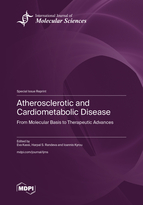Atherosclerotic and Cardiometabolic Disease: From Molecular Basis to Therapeutic Advances
A special issue of International Journal of Molecular Sciences (ISSN 1422-0067). This special issue belongs to the section "Molecular Pathology, Diagnostics, and Therapeutics".
Deadline for manuscript submissions: closed (30 June 2022) | Viewed by 73466
Special Issue Editors
2. Unit of Endocrinology, First Department of Propaedeutic Internal Medicine, Laiko Hospital, National & Kapodistrian University of Athens, 11527 Athens, Greece
Interests: women's health; cardiovascular endocrinology; atherosclerosis; non-alcoholic fatty liver disease; endocrinology of adrenals; oestrogen receptor signalling; glucocorticoid receptor signalling; clock system in benign diseases and malignancies; ICI (immune checkpoint inhibitor)-related endocrinopathies; neuroendocrine tumours; vitamin D; calcium and phosphate metabolic disorders; gynaecological cancers
Special Issues, Collections and Topics in MDPI journals
2. Warwickshire Institute for the Study of Diabetes, Endocrinology and Metabolism (WISDEM), University Hospitals Coventry and Warwickshire NHS Trust, Coventry CV2 2DX, UK
Interests: women's health; endocrinology; gynaecological cancers; PCOS; metabolism; nutrition; diabetes; endocrine-disrupting chemicals (EDCs); links between obesity and cancer
Special Issues, Collections and Topics in MDPI journals
2. Warwickshire Institute for the Study of Diabetes, Endocrinology and Metabolism (WISDEM), University Hospitals Coventry and Warwickshire NHS Trust, Coventry CV2 2DX, UK
3. Centre for Sport, Exercise and Life Sciences, Research Institute for Health & Wellbeing, Coventry University, Coventry CV1 5FB, UK
4. Aston Medical School, College of Health and Life Sciences, Aston University, Birmingham B4 7ET, UK
5. Laboratory of Dietetics and Quality of Life, Department of Food Science and Human Nutrition, School of Food and Nutritional Sciences, Agricultural University of Athens, 11855 Athens, Greece
Interests: metabolism and energy homeostasis; nutrition; cardiovascular endocrinology; cardiovascular disease and atherosclerosis; exercise and health; COVID 19; epidemiology of non-communicable diseases and public health; obesity and obesity-related complications; type 2 diabetes; non-alcoholic fatty liver disease (NAFLD); endocrinology; endocrine-disrupting chemicals; polycystic ovary syndrome (PCOS); mental-health stress and the HPA axis
Special Issues, Collections and Topics in MDPI journals
Special Issue Information
Dear Colleagues,
Over the past decades, important progress has been made in the field of molecular biology of atherogenesis, however, there are still gaps in the knowledge of the underlying pathogenesis.
Moreover, diseases such as non alcoholic fatty liver disease/steatohepatitis, diabetes mellitus, arterial hypertension, dyslipidemia, metabolic syndrome, and chronic kidney disease are tightly connected with atherosclerosis, sharing, at least in part, common molecular pathogenetic mechanisms.
Although cardiovascular diseases (CVDs) still remain the number one cause of death globally, lifestyle modification interventions, as well as pharmacological therapies (anti-hypertensive, lipid-lowering drugs etc.) and advances in cardiovascular surgery have led to the reduction of CVD mortality. This highlights the need for both better prevention strategies and novel targeted anti-atherosclerotic therapies which necessitate detailed studying of the underlying disease mechanisms.
Thereby, we invite colleagues to contribute to the present Special Issue with papers focused on a spectrum of atherosclerosis-related topics, ranging from the molecular and cellular pathways of atherogenesis and atherosclerosis-related diseases to novel pharmacological and molecular targets for treatment of atherosclerosis and related diseases.
Assoc. Prof. Eva Kassi
Prof. Harpal S. Randeva
Assist. Prof. Ioannis Kyrou
Guest Editors
Manuscript Submission Information
Manuscripts should be submitted online at www.mdpi.com by registering and logging in to this website. Once you are registered, click here to go to the submission form. Manuscripts can be submitted until the deadline. All submissions that pass pre-check are peer-reviewed. Accepted papers will be published continuously in the journal (as soon as accepted) and will be listed together on the special issue website. Research articles, review articles as well as short communications are invited. For planned papers, a title and short abstract (about 100 words) can be sent to the Editorial Office for announcement on this website.
Submitted manuscripts should not have been published previously, nor be under consideration for publication elsewhere (except conference proceedings papers). All manuscripts are thoroughly refereed through a single-blind peer-review process. A guide for authors and other relevant information for submission of manuscripts is available on the Instructions for Authors page. International Journal of Molecular Sciences is an international peer-reviewed open access semimonthly journal published by MDPI.
Please visit the Instructions for Authors page before submitting a manuscript. There is an Article Processing Charge (APC) for publication in this open access journal. For details about the APC please see here. Submitted papers should be well formatted and use good English. Authors may use MDPI's English editing service prior to publication or during author revisions.
Keywords
- Atherosclerosis
- coronary artery disease
- stroke
- non-alcoholic fatty liver disease
- diabetes mellitus
- metabolic syndrome
- plaque stability
- endothelial cells
- vascular inflammation
- antidiabetic drugs
- antihypertensive treatments
- lipid lowering treatments
- lifestyle interventions
- molecular targeted therapies







